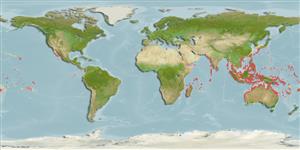Common names from other countries
Environment: milieu / climate zone / depth range / distribution range
বাস্তুসংস্থান
; গভীরতার পরিসীমা 0 - 20 m (Ref. 349). Tropical
Indo-Pacific.
Length at first maturity / আকৃতি / ওজন / Age
Maturity: Lm ? range ? - ? cm Max length : 11.0 cm SHL পুরুষ/ লিঙ্গ অনিধর্ারিত ; (Ref. 349); common length : 8.0 cm SHL পুরুষ/ লিঙ্গ অনিধর্ারিত ; (Ref. 349)
Traditionally used in Melanesia for the decoration of boats. Occasionally used as food, but mainly collected for its shell (Ref. 349). In shallow waters, it is near black, soft corals or sponges (Ref. 799). Common on the large fleshy soft coral Sarcophyton (Ref. 349).
Life cycle and mating behavior
পরিপক্কতা | প্রজনন | ডিম ছাড়া | ডিমসমূহ | ডিম্বধারন ক্ষমতা | শুককীট
Members of the order Neotaenioglossa are mostly gonochoric and broadcast spawners. Life cycle: Embryos develop into planktonic trocophore larvae and later into juvenile veligers before becoming fully grown adults.
Poutiers, J.M. 1998. (Ref. 349)
IUCN Red List Status (Ref. 130435)
CITES status (Ref. 108899)
Not Evaluated
Not Evaluated
Threat to humans
Harmless
Human uses
| FishSource |
হাতিয়ার
আরো তথ্য
Age/Sizeবৃদ্ধিLength-weightLength-lengthবহিঃ অঙ্গ সংস্থানশুককীট প্রাচুর্য
ইন্টারনেট সুত্র
Estimates based on models
Preferred temperature
(Ref.
115969): 24.2 - 29.3, mean 28.4 (based on 3368 cells).
Vulnerability
Low vulnerability (10 of 100).
Price category
Unknown.
